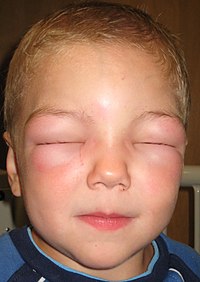
Photo from wikipedia
Background: Hereditary angioedema (HAE) patients suffer from recurrent swellings. Current standard therapy consists of C1 esterase inhibitor (C1-INH) and bradykinin receptor B2 antagonists. Severe courses require prophylactic treatment. For such… Click to show full abstract
Background: Hereditary angioedema (HAE) patients suffer from recurrent swellings. Current standard therapy consists of C1 esterase inhibitor (C1-INH) and bradykinin receptor B2 antagonists. Severe courses require prophylactic treatment. For such patients, it has been demonstrated that the intravenous (IV) administration of C1-INH [C1-INH(IV)] is safe and effective. A new prophylactic option is subcutaneous (SC) treatment with C1-INH. Methods and Case: We present the case of an HAE patient placed on prophylactic C1-INH(IV) therapy due to frequent attacks when managed with on-demand therapy. An implanted port allowed the periodical and safe application of medication until the device was explanted due to an infection. Due to the poor venous access, repeated IV application failed. Therefore, we began a SC treatment with 1500 IU C1-INH [C1-INH(SC)] as long-term prophylaxis and analyzed the clinical course over 16 months. Results: Under the SC prophylaxis, the number of attacks were reduced to 1/month in comparison to 4.33/month with no prophylactic treatment and 1.83/month with C1-INH(IV). No severe attacks and no attack within the upper airway occurred over the 16 months of C1-INH(SC) treatment. As a result, quality of life improved, as measured by the Angioedema quality of life questionaire (AE-QoL). Conclusion: Self-administered SC prophylactic use of C1-INH over a period of 16 months seems to be a well tolerated and efficient. The patient’s quality of life improved, and by learning self-application, the patient gained independence.
Journal Title: Journal of Pharmacy Practice
Year Published: 2019
Link to full text (if available)
Share on Social Media: Sign Up to like & get
recommendations!